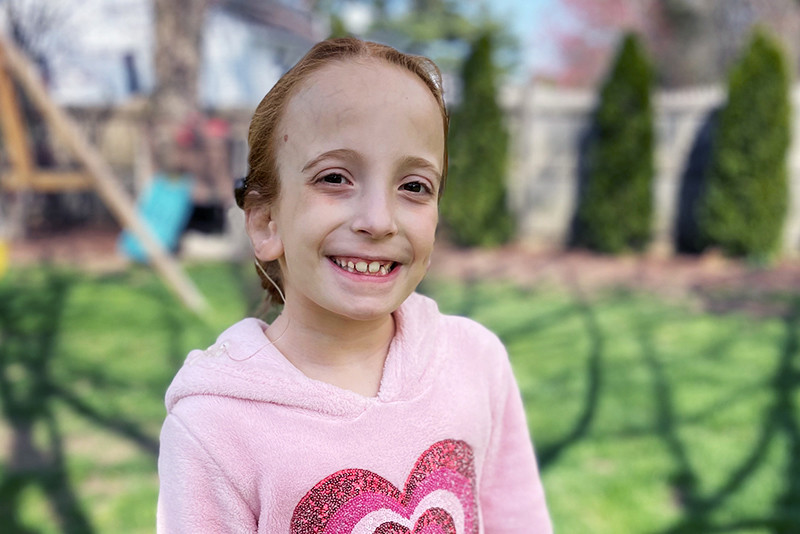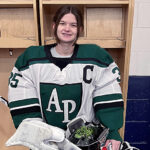Overcoming microtia, atresia, and speech challenges: Braelyn’s story

Eight-year-old Braelyn is a sweet, confident kid who loves everyone, dotes on her little sister Kamryn, does well in school, and never stops moving. Her parents, Danielle and Joseph, are incredibly grateful to see their daughter happy and thriving, especially after the long road it took to get here, including pharyngeal flap surgery and ear reconstruction with the Microtia Program at Boston Children’s Hospital.
Diagnosis at delivery and coordinated care

At her delivery, doctors at Danielle’s local hospital discovered that Braelyn had an underdeveloped right ear — a condition called microtia — and a closed ear canal (atresia), rendering her with significant hearing loss in that ear. Despite multiple ultrasounds during a closely monitored pregnancy, the conditions were never picked up on.
Braelyn was born early and spent the first few weeks of her life in that hospital’s NICU, where they coordinated care with Boston Children’s physicians, including Dr. Greg Licameli, a pediatric otolaryngologist, who initially managed the care of her hearing loss.
Managing hearing loss and speech at a young age
When Braelyn was 3, she was fitted for a bone conduction hearing aid, which captures sound and transfers it directly to the cochlea (the hearing organ in the inner ear) through bone vibrations. While it helped her hearing, the headband-like device wasn’t without challenges.
“It was difficult to keep the hearing aid on her head at times,” Danielle remembers. “And there would be sound interference if her hair got in it or when she’d lie down.”
At about the same time, Braelyn was diagnosed with velopharyngeal insufficiency (VPI), a condition where the soft palate and throat don’t close completely to separate the mouth and nose while speaking and eating. VPI can make speech hard to understand. Braelyn underwent pharyngeal flap surgery with Dr. John Meara, which takes tissue from the back of the throat and connects it to the soft palate (the velum), narrowing the space between the mouth and nose to improve Braelyn’s ability to produce sounds.
“I guess I didn’t notice because I’m her mother and could ‘speak Braelyn’,” Danielle says of how Braelyn vocalized sounds before the surgery. “But looking back at videos, I realize that she spoke with a lot of grunting, probably because she couldn’t hear or make sounds. So having the flap surgery was huge.”
Microtia Program helps navigate reconstructive options
In addition to managing her hearing loss, addressing the appearance of Braelyn’s underdeveloped ear had been in the back of her parents’ minds since the beginning. Danielle and Joseph put a lot of consideration into which reconstructive approach to take and when to take it.
“We waited for her to bring up her ear on her own,” Danielle says. “She always knew she had a little ear, but it never bothered her, which I was happy about. But around 6 and a half, she started to ask more questions about it and said she wanted her little ear to look like her other one.”
Dr. Licameli connected Danielle and Joseph to the Microtia Program to help her map out Braelyn’s surgical options. When Danielle met with Dr. Carolyn Rogers-Vizena to discuss constructing a new ear with Medpor, a porous plastic material that gets wrapped with the patient’s own tissue, she knew Braelyn was in the right hands.
“The second I walked into her office, I just knew,” says Danielle of Dr. Rogers-Vizena. “She’s compassionate, thoughtful, and has an amazing bedside manner.”
Granting Danielle’s hope to minimize the number of surgeries Braelyn would undergo, Dr. Rogers-Vizena was able to work with otolaryngologist Dr. Gi Soo Lee, director of the Bone Anchored Hearing Systems program, on a dual surgery of sorts that simultaneously gave Braelyn a customized ear and provided her with a more stable hearing aid that fit securely behind her new, permanent ear. “It was a big request to coordinate two doctors in the OR at the same time for such a long surgery,” says Danielle. “But Boston Children’s was so great about coordinating the hearing aid placement with the reconstruction.”
Excited to share her story
Danielle says that Braelyn’s ear anomaly and hearing aids never dampened her spirit, but her new ear and affixed hearing aid have increased her self-confidence and given her the desire to help others. Danielle said Braelyn was excited to share her story with those who may be going through something similar.
“She wants to help other kids who have special ears like she does.”
Learn about the Mircrotia Program at Boston Children’s Hospital.
Related Posts :
-

A different kind of hearing: Caleb’s cochlear implant
Caleb recently told his mother, “I think I’m going to write my own stories.” This news didn’t surprise ...
-

A kiss from their sister: A family’s journey with cleft lip care
Kelly and Ben’s experience with cleft lip care at Boston Children’s Hospital spans multiple years and multiple children. ...
-

How I hear you: Isabelle’s cochlear implant story
Isabelle is a thriving AP student, hockey player, and online gamer who listens to music and communicates with the help ...
-

Gene therapy with a new base editing technique restores hearing in mice
Using a new genetic engineering technique, known as base editing, researchers from Boston Children’s Hospital and the Broad Institute ...





